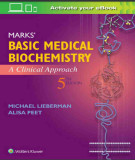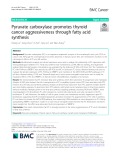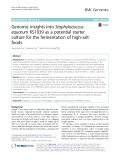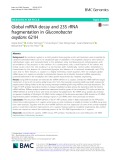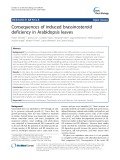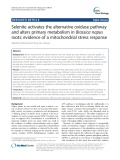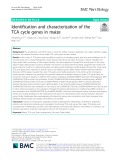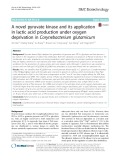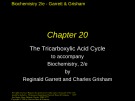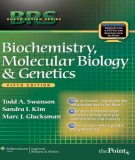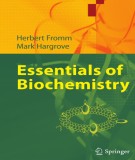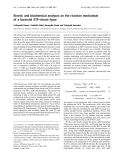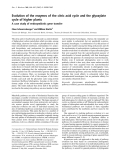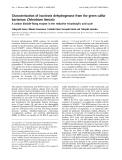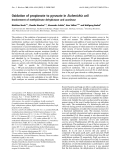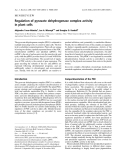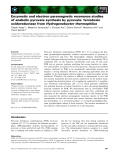
Tricarboxylic acid cycle
-
Part 1 book "Medical biochemistry" includes content: Introduction, amino acids and proteins, carbohydrates and lipids, membranes and transport, oxygen transport, catalytic proteins enzymes, vitamins and minerals, bioenergetics and oxidative metabolism, anaerobic metabolism of carbohydrates in the red blood cell, the tricarboxylic acid cycle, oxidative metabolism of lipids in liver and muscle, biosynthesis and storage of carbohydrate in liver and muscle,... and other contents.
 401p
401p  muasambanhan02
muasambanhan02
 18-12-2023
18-12-2023
 4
4
 1
1
 Download
Download
-
Part 2 book "Marks' basic medical biochemistry - A clinical approach" includes content: Basic concepts in the regulation of fuel metabolism by insulin; glucagon, and other hormones, cellular bioenergetics - adenosine triphosphate and O2; digestion, absorption, and transport of carbohydrates; generation of adenosine triphosphate from glucose, fructose, and galactose - glycolysis; tricarboxylic acid cycle; oxidative phosphorylation and mitochondrial function; oxygen toxicity and free radical injury; formation and degradation of glycogen.... and other contents.
 366p
366p  oursky07
oursky07
 24-10-2023
24-10-2023
 4
4
 3
3
 Download
Download
-
Pyruvate carboxylase (PC) is an important anaplerotic enzyme in the tricarboxylic acid cycle (TCA) in cancer cells. Although PC overexpression has been observed in thyroid cancer (TC), the mechanisms involved in the carcinogenic effects of PC are still unclear.
 17p
17p  vimahuateng
vimahuateng
 26-11-2021
26-11-2021
 8
8
 2
2
 Download
Download
-
Our previous comparative genomic analysis of Staphylococcus equorum KS1039 with five S. equorum strains illuminated the genomic basis of its safety and salt tolerance. However, a comprehensive picture of the cellular components and metabolic pathways involved in the degradation of macromolecules and development of sensory properties has not been obtained for S. equorum. Therefore, in this study, we examined the general metabolism of S. equorum based on information obtained from published complete genome sequences of six S. equorum strains isolated from different niches.
 9p
9p  vibeauty
vibeauty
 23-10-2021
23-10-2021
 12
12
 0
0
 Download
Download
-
Gluconobacter oxydans is a strictly aerobic Gram-negative acetic acid bacterium used industrially for oxidative biotransformations due to its exceptional type of catabolism. It incompletely oxidizes a wide variety of carbohydrates regio- and stereoselectively in the periplasm using membrane-bound dehydrogenases with accumulation of the products in the medium.
 17p
17p  vitzuyu2711
vitzuyu2711
 29-09-2021
29-09-2021
 11
11
 1
1
 Download
Download
-
The identification of brassinosteroid (BR) deficient and BR insensitive mutants provided conclusive evidence that BR is a potent growth-promoting phytohormone. Arabidopsis mutants are characterized by a compact rosette structure, decreased plant height and reduced root system, delayed development, and reduced fertility.
 14p
14p  viminato2711
viminato2711
 22-05-2020
22-05-2020
 20
20
 1
1
 Download
Download
-
Human requirements for dietary selenium are met mainly by crops. However, excessive uptake of selenium in plants can restrict growth, and its toxicity has been postulated to target roots.
 15p
15p  viminato2711
viminato2711
 22-05-2020
22-05-2020
 15
15
 0
0
 Download
Download
-
The tricarboxylic acid (TCA) cycle is crucial for cellular energy metabolism and carbon skeleton supply. However, the detailed functions of the maize TCA cycle genes remain unclear.
 16p
16p  viharuno2711
viharuno2711
 21-04-2020
21-04-2020
 13
13
 2
2
 Download
Download
-
Pyruvate kinase (Pyk) catalyzes the generation of pyruvate and ATP in glycolysis and functions as a key switch in the regulation of carbon flux distribution. Both the substrates and products of Pyk are involved in the tricarboxylic acid cycle, anaplerosis and energy anabolism, which places Pyk at a primary metabolic intersection.
 12p
12p  vihamax2711
vihamax2711
 21-04-2020
21-04-2020
 19
19
 1
1
 Download
Download
-
The glycolytic pathway converts glucose to pyruvate and produces two molecules of ATP per glucose only a small fraction of the potential energy available from glucose. Under anaerobic conditions, pyruvate is reduced to lactate in animals and to ethanol in yeast, and much of the potential energy of the glucose molecule remains untapped. In the presence of oxygen, however, a much more interesting and thermodynamically complete story unfolds.
 56p
56p  tangtuy15
tangtuy15
 30-06-2016
30-06-2016
 27
27
 4
4
 Download
Download
-
(BQ) Part 1 of the document BRS Biochemistry, molecular biology and genetics presents the following contents: Organic chemistry review; protein structure and function; enzymes, biochemistry of digestion; glycolysis; the tricarboxylic acid cycle, electron transport chain, and oxidative metabolism; glycogen metabolism; gluconeogenesis and the maintenance of blood glucose levels,... and other contents.
 180p
180p  thangnamvoiva2
thangnamvoiva2
 25-06-2016
25-06-2016
 45
45
 3
3
 Download
Download
-
(BQ) Continued part 1, part 2 of the document Endocrine physiology presents the following contents: Carbohydrate metabolism A - Glycolysis and gluconeogenesis; the tricarboxylic acid cycle; carbohydrate metabolism B: Di-, Oligo-, and polysaccharide synthesis and degradation; lipid metabolism, amino acid metabolism; nucleotide metabolism, photosynthesis; DNA, RNA, and protein metabolism.
 200p
200p  thangnamvoiva2
thangnamvoiva2
 23-06-2016
23-06-2016
 40
40
 3
3
 Download
Download
-
Modelling of the fluxes in central metabolism can be performed by combining labelling experiments with metabolite balancing. Using this approach, multiple samples from a cultivation of Saccharomyces cerevisiae in metabolic and isotopic steady state were analysed, and the metabolic fluxes in central metabolism were estimated. In the various samples, the estimates of the central metabolic pathways, the tricarboxylic acid cycle, the oxidative pentose phosphate pathway and the anaplerotic pathway, showed an unprecedented reproducibility....
 6p
6p  system191
system191
 01-06-2013
01-06-2013
 38
38
 1
1
 Download
Download
-
The prokaryotic ATP-citrate lyase is considered to be a key enzyme of the carbon dioxide-fixing reductive tricarboxylic acid (RTCA) cycle. Kinetic examination of the ATP-citrate lyase from the green sulfur bacterium Chlorobium limicola (Cl-ACL), an a4b4 heteromeric enzyme, revealed that the enzyme displayed typical Michaelis-Menten kinetics toward ATP with an apparent Km value of 0.21 ± 0.04 mM. However, strong negative cooperativity was observed with respect to citrate binding, with a Hill coefficient (nH) of 0.45. ...
 8p
8p  research12
research12
 01-06-2013
01-06-2013
 39
39
 3
3
 Download
Download
-
The citric acid or tricarboxylic acid cycle is a central element of higher-plant carbon metabolism which provides, among other things, electrons for oxidative phosphorylation in the inner mitochondrial membrane, intermediates for aminoacid biosynthesis, and oxaloacetate for gluconeogenesis from succinate derived from fatty acids via the glyoxylate cycle in glyoxysomes. The tricarboxylic acid cycle is a typical mitochondrial pathway and is widespread among a-proteobacteria, the group of eubacteria as de®ned under rRNA systematics from which mitochondria arose. ...
 16p
16p  research12
research12
 01-06-2013
01-06-2013
 41
41
 3
3
 Download
Download
-
Isocitrate dehydrogenase (IDH) catalyzes the reversible conversion between isocitrate and 2-oxoglutarate accom-panied by decarboxylation/carboxylation and oxidoreduc-tion of NAD(P) + cofactor.While this enzyme has beenwell studiedas a catabolic enzyme in the tricarboxylicacid (TCA) cycle, here we have characterized NADP-dependent IDH fromChlorobiumlimicola, agreen sulfur bacteriumthat ®xes CO2 through the reductive tricarboxylic acid (RTCA) cycle, focusing on theCO2-®xation ability of the enzyme. ...
 6p
6p  research12
research12
 23-04-2013
23-04-2013
 42
42
 1
1
 Download
Download
-
The pathway of the oxidation of propionate to pyruvate in Escherichia coliinvolves five enzymes, only two of which, methylcitrate synthase and 2-methylisocitrate lyase, have been thoroughly characterized. Here we report that the isomerization of (2S,3S)-methylcitrate to (2R,3S)-2-methyl-isocitrate requires anovel enzyme,methylcitratedehydratase (PrpD), and the well-known enzyme, aconitase (AcnB), of the tricarboxylic acid cycle.
 11p
11p  tumor12
tumor12
 22-04-2013
22-04-2013
 46
46
 3
3
 Download
Download
-
The pyruvate dehydrogenase complex (PDC) is subjected to multiple interacting levels of control in plant cells. The first level is subcellular compartmentation. Plant cells are unique inhaving twodistinct, spatially separated forms of the PDC; mitochondrial (mtPDC) and plastidial (plPDC). The mtPDCis the site of carbon entry into the tricarboxylic acid cycle, while the plPDCprovides acetyl-CoAandNADHfor de novofatty acid biosynthesis.
 7p
7p  tumor12
tumor12
 20-04-2013
20-04-2013
 28
28
 1
1
 Download
Download
-
Erythrocytic stages of the malaria parasitePlasmodium fal-ciparumrely on glycolysis for their energy supply and it is unclear whether they obtain energy via mitochondrial res-piration albeit enzymes of the tricarboxylic acid (TCA) cycle appear to be expressed in these parasite stages. Isocitrate dehydrogenase (ICDH) is either an integral part of the mitochondrial TCA cycle or is involved in providing NADPH for reductive reactions in the cell.
 9p
9p  fptmusic
fptmusic
 16-04-2013
16-04-2013
 50
50
 1
1
 Download
Download
-
Pyruvate: ferredoxin oxidoreductase (POR; EC 1.2.7.1) catalyzes the thia-mine pyrophosphate-dependent oxidative decarboxylation of pyruvate to form acetyl-CoA and CO2 . The thermophilic, obligate chemolithoauto-trophic hydrogen-oxidizing bacterium, Hydrogenobacter thermophilusTK-6, assimilates CO2 via the reductive tricarboxylic acid cycle.
 10p
10p  mobifone23
mobifone23
 18-01-2013
18-01-2013
 47
47
 4
4
 Download
Download
CHỦ ĐỀ BẠN MUỐN TÌM









